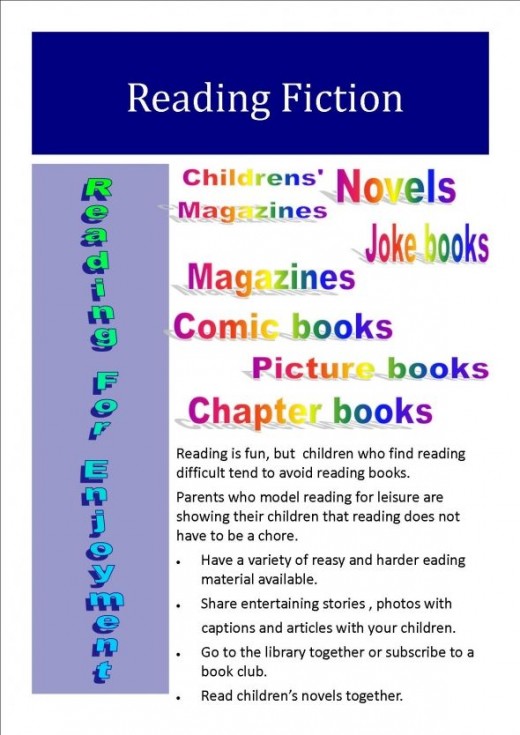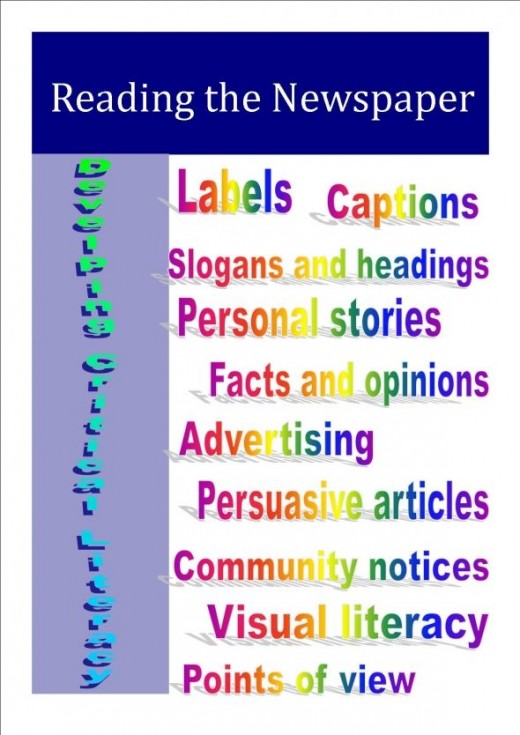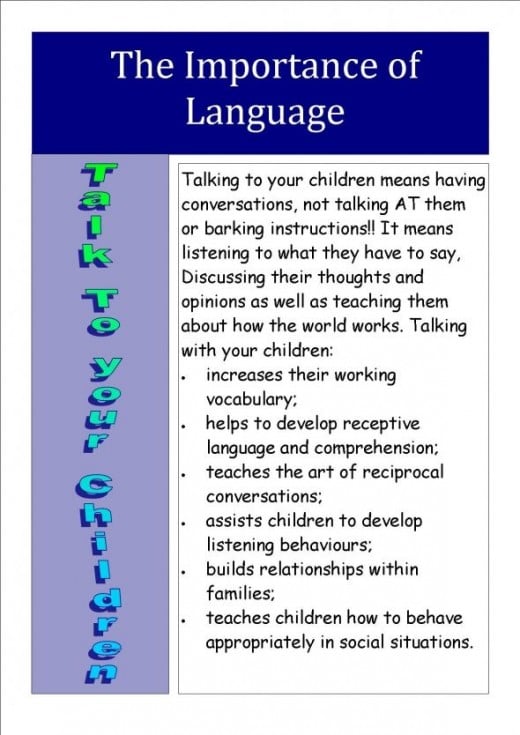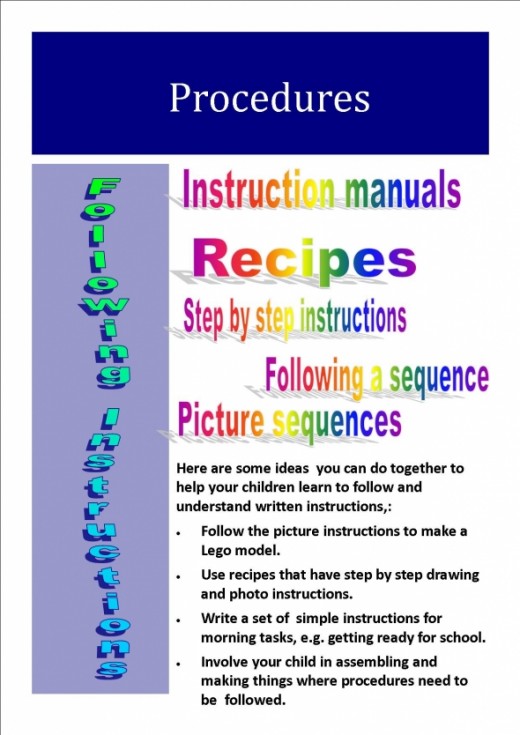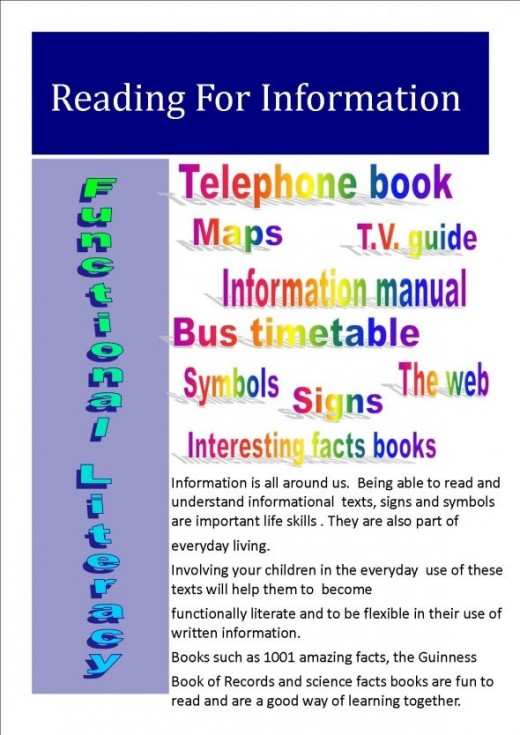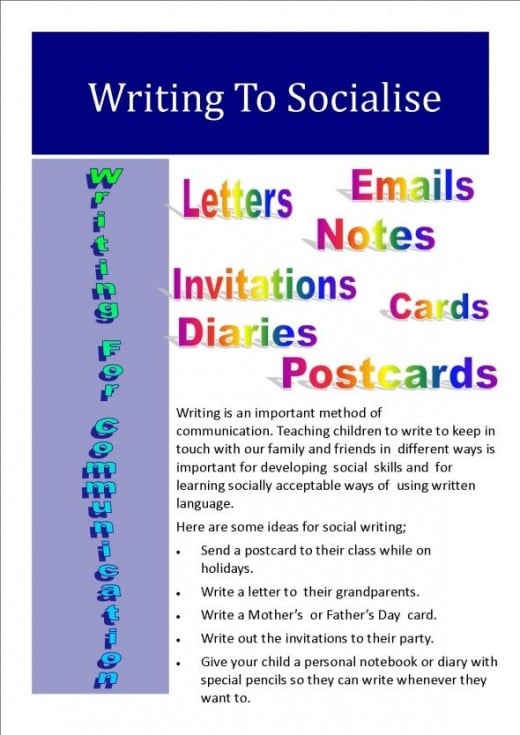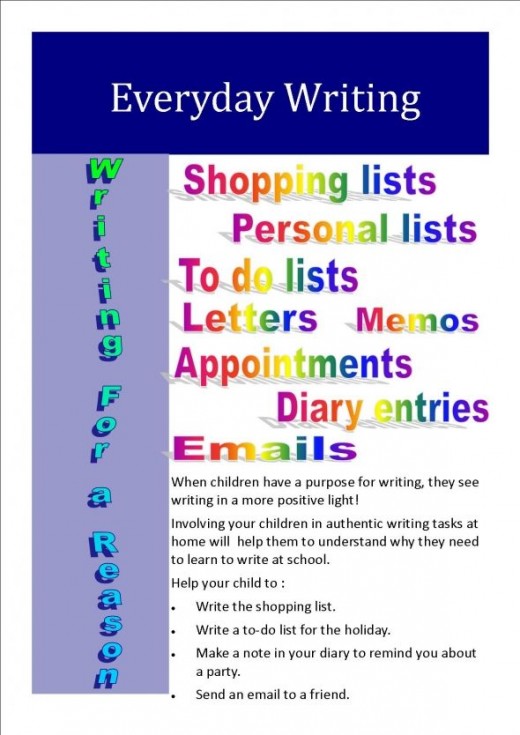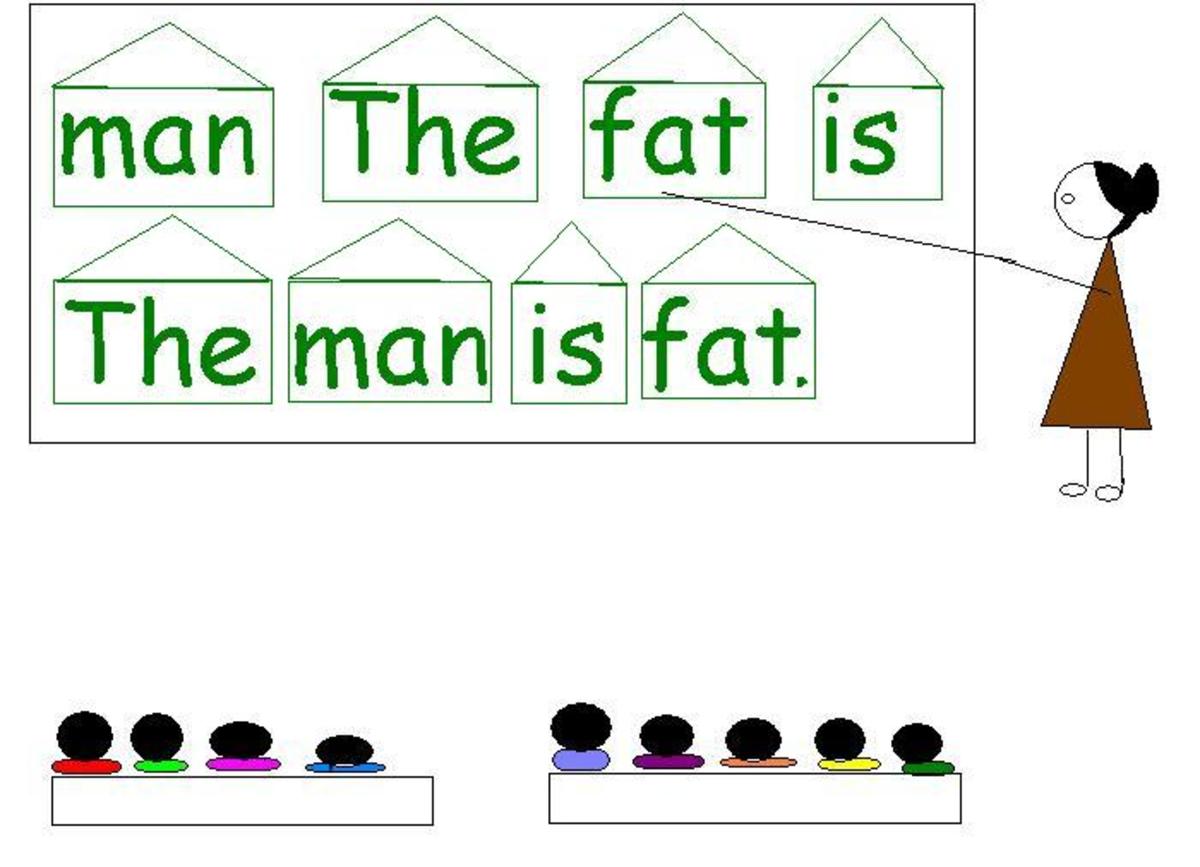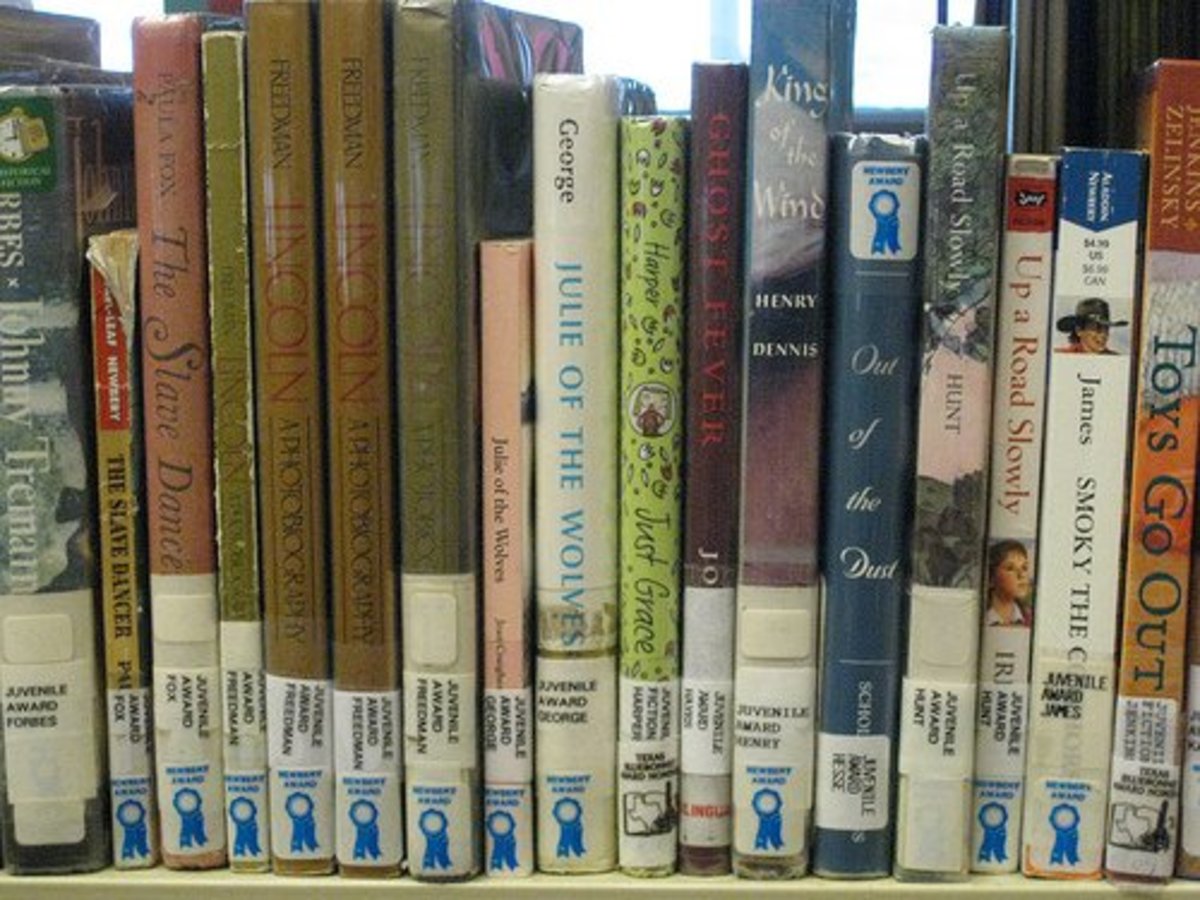Literacy Teacher's Workshop
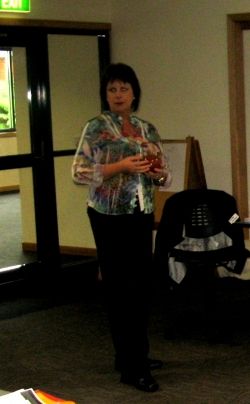
Victoria Cochrane's Reading Page
Welcome to my first literacy page, of which the theme is Teaching Reading. It is full of reading teaching tips, ideas, photos, videos and suggestions. Please feel free to give me feedback or to ask questions, and I will endeavour to answer as quickly as I can!
What is Victoria Cochrane About?
The Philosophies and Beliefs Underlying My Teaching.
All children can learn and have the right to a quality education.
Teachers must have high expectations of all children, even those with special needs or who are experiencing learning difficulties.
High expectations must be accompanied by focused, explicit teaching.
Teachers must constantly assess for and be aware of each child's learning needs.
Start with what the child knows to teach them something unknown.
Start with where the child is at-starting anywhere else is a waste of time.
All children go through the same stages and phases but they get there in different ways and at different times.
Literacy is a social practice and all learning is a social construction.
Children learn through experiences and by linking them to their own experiences.
Children are a product of their environment. A child's early language experiences set them up for future literacies.
Expert readers and writers always have a purpose when they read and write. Children must be taught that we write in different ways for a purpose and an audience.
Reading and writing are inexplicably linked. It is up to us to make the connections explicit to children.
Good reading and writing practices must be modelled and re-modelled, practiced and practiced and practiced.
Children should read and write every day.
Do you know the philosophies and beliefs underlying your teaching practice?
Research indicates that the more aware educators are of the pedagogies driving their practices, the stronger and more focused their teaching will be (Anstey & Bull, 2003).
Why not have a go at writing down your beliefs about teaching and learning. You may be surprised!
Teaching Reading
What Do Good Readers Do?
As expert readers and writers, we manipulate the written word to suit our own purposes every day. We have a large tool bag of strategies, and a knowledge of all the text types and genres that are available to us to enable us to communicate our thoughts to others. Expert readers and writers almost always have their audience and the purposes for writing in their mind before and when they are writing. Children, on the other hand, are still developing the skills and knowledge for communicating their ideas efficiently when writing.
So, what do expert readers actually do?
Expert readers:
Use their background knowledge to make connections to and make meaning from new information.
Use contexts to make predictions.
Monitor their own reading by asking questions such as, “Does that make sense? Does it sound right? Does it look right?”
Use spelling cues to help them decode words.
Use a range of strategies to decode and make meaning from print, such as: Sounding out a words, using the beginning sound, looking at the picture, rereading a word or phrase, reading on and reading back.
Use analogy to decode unfamiliar words, e.g. I know ‘like’, so that must say ‘bike’.
Use one-to-one matching and other location skills to find specific print.
Cross check information. If they can’t decode a work, they may use a meaning strategy, or they may look at the structure of a word or listen to how it sounds in the context of a sentence.
Analyse what they have read and forms an opinion about it.
Create pictures in their mind as they read.
Overall, expert readers understand that we read for meaning and comprehension, otherwise, it is not worth reading!
What Do We Do When We Read?
Using the Four Resources Model.
Luke and Freebody (1998) identified four things that good readers do when they read.
1. Text participant (Meaning Maker): We link what we are reading to our own experiences and form new meanings through the text. We respond to the text through these links.
2. Text User (Genres): We read texts in different ways and assign meanings to them according to their purpose. We use and accept different language according to the genre or text type; e.g a news article and a text message.
3. Text analyst (Critic): We analyse what we read and form opinions on whether we agree or disagree according to our background knowledge and personal experiences.
4. Code Breaker (Decoder): We use our knowledge of letters, sounds and words to break the code. We also use other strategies to break words and phrases down.
We need to teach children to do all of these things. Notice that decoding is only one part of reading-it is not enough on its own. Using the four resources model as a basis for questioning around texts is a powerful tool for teaching comprehension and critical thinking,
Below is a guide to questioning using the Four Roles of the Reader.
Text Participant
What is this text about?
Have you ever had this experience?
What do you know already about this topic?
Which character do you like best?
What do you predict will happen?
Why did the character feel that way?
How does the story/text make you feel?
What did you find interesting?
What would you like to read more about?
Would you recommend this text? Why or why not? Text User
What do you know about this text type?
What structures and features would you expect to see?
Which purposes and audiences are this text for?
What are the different ways you can use this text?
When would you use this text?
What kind of people would use this text?
Does this text remind you of another text?
Where would you see/use a text like this?
Text Analyst
What were you wondering about after reading this text?
What message is the author trying to convey?
Do you agree with the author's stance?
What is the author trying to make you believe?
What is the plot of this text?
Do you think this text is successful?
How would you change this text?
To what degree do you agree/disagree?
Why did the author choose to write the text this way?
How did the author capture your interest? Code Breaker
What strategies did/could you use to read hard words?
Did that make sense?
What else can you try when you are stuck on a word?
What words/phrases are effective in conveying the message?
How did you work out words you don't know?
What is different in this sentence/on this page?
What effect does the exclamation mark have on reading that sentence?
What happens when you read through the full stops?
Teaching For Strategies in Reading:
Using a Range of Teaching Procedures
Introduction: Why do we teach reading?
Teaching reading is a complex process that requires the teacher to use a
range of approaches for scaffolding and supporting students while they
develop the many skills and strategies they need to become proficient
readers.
The major aim of any reading program should be to develop confident, independent readers who can draw on a range of strategies for decoding and comprehending a wide range of texts(Annandale et. al., 2005). Each reading procedure that a teacher uses with students involves a varying degree of responsibility for both the teacher and the student (Annandale et. al., 2005).
When teachers are aware of the different reading procedures that are available to use, and become proficient at using them, they are ensuring that explicit instruction and guidance, as appropriate, is balanced with regular opportunities for the independent application and practise of skills and strategies (Annandale et. al., 2005).
The Reading Procedures:
Teaching reading in a small-group or individual focused learning session is essentially more powerful and effective than listening to students read once or twice a week. It involves focused, explicit teaching that is intentionally directed to the individual learning needs of students. it is also a way of the teacher using the appropriate teaching procedure according to the learning needs and abilities of particular students.
The different teaching procedures are:
Reading to students
Modelled reading
Shared reading
Guided reading
Reciprocal Reading
Book discussion groups
Independent reading.
Conclusion:
Using all procedures as appropriate in their literacy planning will ensure that
teachers are using effective practices for teaching reading with their students.
A wealth of literature is available for teachers to learn more about the teaching
procedures, but the best way to learn is to view teachers who are proficient with the strategies in action.
References:
Annandale, K., Bindon, R., Handley, K., Johnston. A., Lockett, L and Lynch, P. (2003). First Steps reading resource
book; Addressing current literacy challenges. Melbourne, Vic: Rigby Heinemann Harcourt Books.
Annandale, K., Bindon, R., Handley, K., Johnston. A., Lockett, L and Lynch, P. (2003). Linking assessment, teaching and learning; Addressing current literacy challenges. Melbourne, Vic: Rigby Heinemann Harcourt Books.
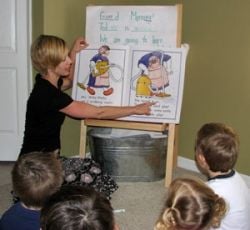
Teaching the Conventions of Print
Shared Reading
Shared reading is an interactive reading experience, usually done with a big book or large text that the children can read along with. Children join in the reading of a big book or other enlarged text while the teacher points to each word and reads aloud. Shared reading is an ideal teaching strategy for modelling what good readers do. It is also an excellent way to teaching concepts about print. Teachers should have a teaching focus before reading, such as modelling fluency, reading punctuation or 1-1 matching of print and the spoken word.
While shared reading is ideal as a tunin- in, whole-class activity, it is also very useful in small teaching groups with pre-emergent and emergent readers.
Shared reading can be combined with Language Experience, which uses the children's own writing as reading material. Short, predictable texts are ideal for teaching students important concepts such as the difference between print and pictures, the difference between a letter, number, word and a sentence, using the beginning sounds of a word; capital and lowercase letters, directionality, 1 to 1 matching etc. I recommend that shared reading/language experience be used in place of guided reading until students are ready for Reading Recovery levels.
The Explicit Teaching of Reading Strategies
Guided Reading
Guided Reading
Traditionally uses levelled texts to match students to their instructional level.
Can use fiction or non-fiction texts.
Is best done in small like-ability groups of no more than six.
The teacher will have a focus or foci in mind in each lesson for explicit teaching according to the identified learning needs of the students.
The teacher gives the language and essence of the text. This is not round-robin or shared reading.
If the book is non-fiction, there may also be teaching around the particular text type.
The children then read the text independently, with the teacher listening to individuals read. She may also take running records.
Planning for Guided Reading
Assess all students' reading levels and abilities.
Running Records
Observational checklists
First Steps Map of Development
Anecdotal Records
Home Reading comments
Student self assessments
Conversations with colleagues and parents.
Group students according to like abilities and needs for ease of planning for and teaching to similar needs. There may be times when multi ability or flexible groupings are appropriate according to the teaching purpose.
Set short term targets for each group. Keep the learning goals limited and focused.
What are their strengths?
What are the priorities for the next month for the students in each group? There may be many teaching priorities but limiting them to a few at a time will result in more explicit and focussed teaching overall.
What are the major teaching focuses for each group?
What strategies, texts and activities will you use?
How will you assess?
Choose texts carefully with the students' needs and teaching focuses in mind. For instance, beware of texts containing words to compound letter confusions (a book that repeats the word bed will confuse a child with a b/d confusion) or texts that may contain concepts beyond younger, more fluent readers.
Plan for each session:
Major teaching focus/es; reading strategies
Teaching sequence
Questioning for comprehension using four roles of the reader
Follow up activities to reflect focus and demonstrate understanding.
Reflection
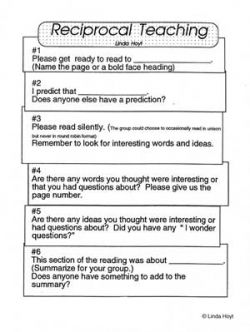
Guided Reading, Reciprocal Teaching
Teaching for Comprehension
Reciprocal teaching is a teaching strategy for upper primary students. Whereby the guided reading strategy focuses on teaching students the processes of reading, reciprocal teaching requires that the students will be able to decode the text without difficulty. The focus for the teacher, then, is on comprehension. There are four roles or thinking componenents to the strategy: 1.Predict; 2. Generate questions; 3. Clarify words and their meanings;. 4. Summarise the text.
Reciprocal teaching is designed to be student run, but it is imperative that the teacher model and scafold students with the procedure until they are familiar with it. Younger students who are capable readers may need continued support to verbalise their thinking.
Older students, once familiar with the procedure, can be trained to run the activity independently with the support of prompt cards.
Teachers must choose each text carefully, with the reading and comprehension skills of each group of students forefront of their mind. Ensuring that texts are within the realms of the students' background knowledge is imperative for the development of comprehension. Students must be able to visualise the topic and have had some experience with it in order to build further understandings.
Scholastic now put out an excellent range of reciprocal reading texts called "Into Connectors" for younger readers, and "Connectors" for more competent readers.
Teaching Reading Resources - Excellent Teacher References for Teaching Reading in the Diverse Classroom
Guided Reading/Reciprocal Teaching Resources
Independent Reading Activities
Here are some suggestions for activities that promote practise of reading skills.
Independent Reading Activities.
Text activities– Reconstruction; cut and paste or
reassemble laminated text strips.
-matching text
-matching text and pictures
-sequencing text or pages of book.
Can use copies from guided or shared reading texts.
Read and draw– Read simple instructions and draw.
Reading corner.
Big books.
Poetry box.
Joke box.
Alphabet recognition activities-
Sort magnetic letters and numbers; sort letters by shape, colour or straight/curvy shape; into upper and lower case.
Match upper and lower case cards or magnetic letters; picture with beginning sound.
Play alphabet bingo, snap, dominoes, memory or games.
Do alphabet floor puzzles; play stepping stones.
Play sounds bingo, snap, dominoes or games.
Use magnetic letters to make your name or words.
Handwriting activities-make letters in sand, shaving cream, fingerpaint, paint,or with playdough.
Fine motor activities
Difference between a letter, word and sentence.
Sort letter and word cards.
Sort word and sentence cards.
Sort letters, word and sentence cards.
Use sentence kits to match sentence beginnings and endings. Make silly sentences. Write and draw for your favourite one.
Simple sentence kits-use sentence starters and change the end word. E.g. I like to eat apples/bananas etc.
Cut and paste activities.
Sight Words
Bingo-use dolch words or those from guided reading.
Memory
Make and break, write and draw.
CVC words– onset and rime.
Word wheels.
Make a word game.
Snakes and ladders.
Worksheets.
Make with magnetic letters.
Word families study.
Word slider.
Phonemes.
Chunking games and activities.
Blends bingo and other games.
Computer programs
Worksheets
Cut and paste.
Visual discrimination.
Memory games
Trick snap
Puzzles.
Responding to text .
Paint
Collage
Make and do
Follow the instructions to make…
Draw and label, write a sentence or caption.
Use puppets to retell the story.
Make books-draw for text or write for drawings.
Draw characters or settings or a part of the story etc on the computer.
Use playdough or plasticine to create pictures or characters.s
10 Things I Never Do in My Classroom in Teaching Time
Effective Teaching No-No's
1. Sit at my desk in class time. My desk Is always too cluttered for
that! I spend every minute teaching groups and individuals with no
time for looking good behind a desk.
2. Have children queuing up for work to be corrected. This
practice is ineffective and wastes teaching time. Have a finished
basket or folder where students can put their work for you to check
with them later, either in a conference or before the next guided
reading session.
3. Check my emails while the children are working. This practice
is simply unprofessional.
4. Raise my voice regularly as a form of control. Children take no
notice of teachers who yell or make idle threats that have no
consequences. Set your expectations and use a quiet, calm voice. The
‘death’ stare and waiting in grim silence can be very attentiongetting!
5. Make an example of students who have done the wrong
thing. Children respond to positives and learning from their
mistakes, not humiliation. Even putting their names on the board for
all to see falls under this category.
6. Teach everything to the whole class. There is a place for some
whole class work but, conducted all the time is very ineffective for
meeting individual learning needs. Key words here are whole group,
small group teaching groups, one on one with individuals, use of
cooperative groupings, differentiated learning tasks, use of teaching
strategies such as modelled, shared and guided reading, regular
assessment.
7. Teach straight out of a textbook. Text book programmes are very linear and a very ineffective way of teaching. They are useful when the teacher uses them as tools and selects appropriate material according to the needs of her students.
8. Teach to the worksheet. Worksheets should only be used as consolidation and practice tasks. If they can be avoided, even better!
9. Use worksheets as follow up activities to Guided Reading (Graphic Organisers don’t count as worksheets). Worksheets are often question and answer and, as comprehension tasks, promote lower order thinking. Locating information, responding to the text in their own way, re-telling, innovating, creating the objects or characters described in the text are all much more open ended and promote much higher-order thinking and deeper comprehension.
10. Talk too much. Teachers who talk too much run the risk of overloading their students with too much information or boring them to tears. Teachers who facilitate the learning through questioning, inquiry, open-ended tasks and student directed learning are providing much more powerful learning opportunities for their students.
StickyNote
Reading and writing are problem solving activities. Teach your students to be learners who know how to solve their own problems andto work independently. It will make your life easier and will set them up to be successful life-long learners.
The Most Important Things
*Believe in your students.
*Differentiated curriculum.
*Visual timetables and task management board.
*Explicit teaching using small groups and individual teaching.
*Assessment and monitoring: know your students.
*Planning.
*Supportive classroom environment.
Familiarisation of Information Report. - Whole-group reading activity.
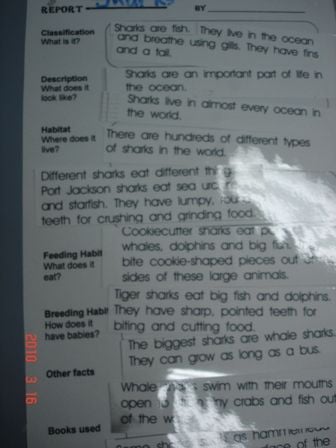
This was an introductory reading activity to information report. A short report on sharks was typed and laminated, along with a report graphic organiser. The class read the report, then sorted each sentence into their categories. No writing took place as children were familiarised with the structure of information report.
Task management board - Reading groups
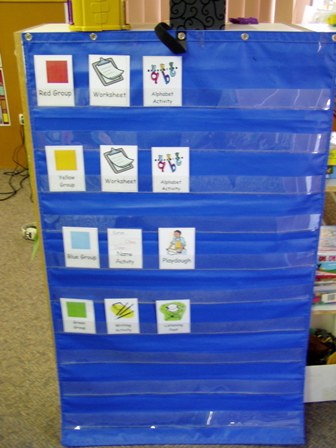
This task management board does not reveal the students in each group. Each student has a coloured dot on their desk mat to match their reading group. The teacher was unwilling for the parents to know which group students were in to avoid comparisons of children and reading levels.
Learning to look at print. - Concepts about print.
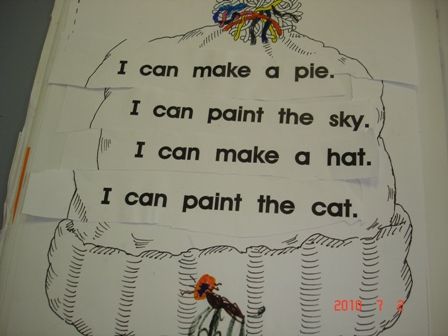
A simple text is used for shared reading. It is then cut into sentence strips for reading and sorting. Pasting should not occur until the text has been read and sorted several times. This activity can be adapted for students with a range of abilities and ages.
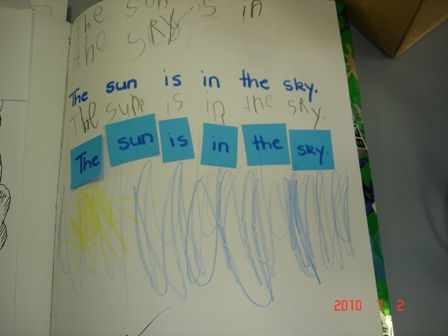
Learning to decode words effectively
Scrabble/Memory with spelling, sight or interest words.
I made up this game with a group of students and it seemed to work well. It is designed to encourage students to chunk and say the sounds in words to develop more effective decoding skills. We only used one word each, but more words per child could be used, depending on the skill level of the children. Afterwards they chose two words to write in sentences. The link between reading and writing was further reinforced by using the cut-up sentence technique. It is vital they read and remake the sentences many times before pasting. I would love to hear from anyone who uses this in their classroom!
1. For every child in the small group, write their word/words on strips of card twice.
2. Cut up one set of words into sounds (not letters). For instance: c-a-t; sh-ee-p; bl-ue. Leave the other strip as a whole word for reference.
3. The students sit in a circle. All the sound cards from all the children's words are spread letter side down in the middle of the circle.
4. The children put their word cards in front of them.
5. Taking it in turns, the children pick up a sound card. If it goes in one of their words they say the sound and match it to the correct word card.. If not they put it back.
6. Keep playing until all the words are remade.
Parent Information Posters - Everyday reading and writing for different purposes that I developed for parent information sessions.
Click thumbnail to view full-size






In-school Consultancy and Support-Developing Best Practice in Literacy and Numeracy.
- Top Level Structure: Why Use Graphic Organisers?
This is my second published article. You can find the article with graphics in the October 2010 issue of Practically Primary, Australian Literacy Educators' Association (ALEA) http://www.alea.edu.au/ - Literacy Intervention in the Classroom
This is the paper I delivered at the National ALEA/AATE English/Literacy conference in Hobart in 2009. It describes the action research I implemented in myGrade 1/2 classroom, with emphasis on the three specific intervention strategies I used to impr - Independent Schools Tasmania Pilot Project 2009-2010: In-school Consultancy and Support-Developing B
This page highlights the work I did as Literacy Adviser for the IST Pilot Project in North West Christian Schools in 2009-2010. There are links to the IST webpage where you can access some of my newsletters for teachers and parents. - Liiteracy and a Supportive Classroom Environment.
This article was published in Octover 2010 in the Victorian journal, "Leadership in Focus".
YouTube - Isabella's Garden
This digital story was a response by the Leighland Christian School, Burnie's Kinder/Prep class to the 2010 Book Week finalist, Isabella's Garden by Glenda Millard. The book tells the story of the seasonal cycle.
Teaching Reading - Guided Reading Reciprocal Teaching
This method for competent readers teaches comprehension and higher-order thinking skills
Steven Layne Books - Teaching the Skills and the Will to Read!
Key Links - Jill Eggleton
Jill Eggleton has a way with words that hooks children into reading.











